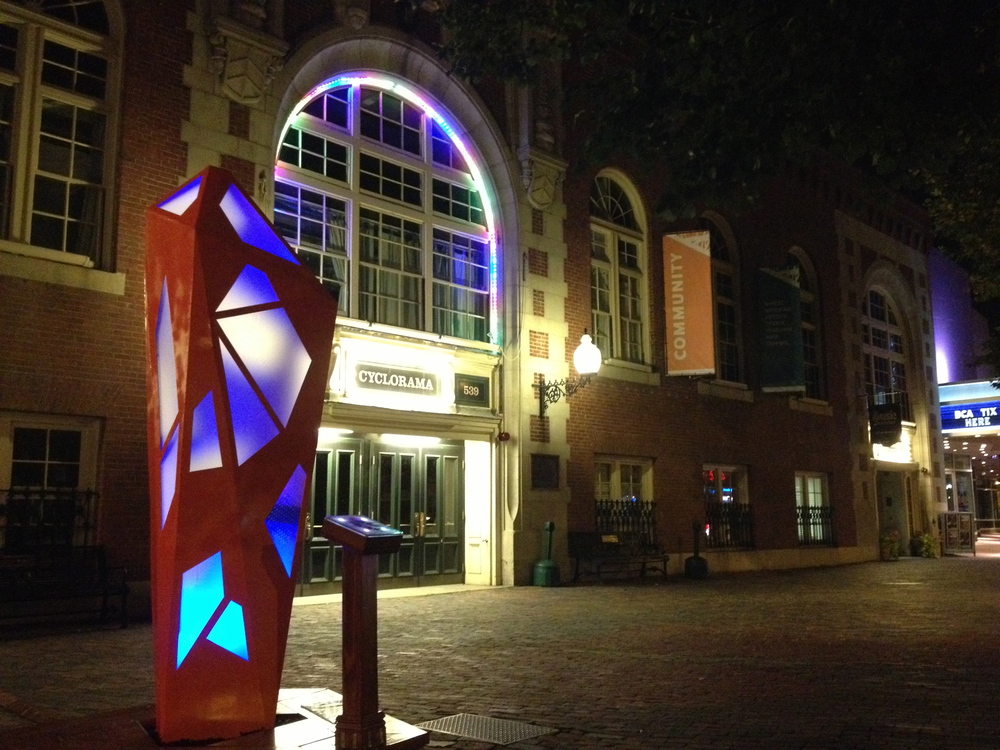Technology and Art in Public Places
I was getting ready to have dinner with a friend from Lesley University when she messaged me and asked if I’d be up for going to the MIT List Center’s Catalyst Conversation Technology and Art in Public Places instead. Even though both my personal art and my community art projects are far from technological, my past three years in Greater Boston and particularly this past year of heavy-duty networking have taught me never to say no to questions like that.
And so I showed up, finding a seat near the front row of the auditorium and listening over the next hour as Pedro Alonzo, Camilo Alvarez, Dan Sternof Beyer, Primavera De Fillipi, Matt Blumberg, George Fifield, and host Ron Mallis described the projects that they have seen and been part of around Boston. Alonzo started the talk by underscoring the importance of “turning down the mic on the expert and giving it to the public,” an inspiring albeit slightly ironic statement coming from a curator of the ICA speaking at a lecture at MIT. He discussed the use of technology in participatory museums and offered both the French street artist JR’s photography project and Google’s Cultural Institute as examples of technology and art merging in public places.
 Alvarez continued with examples of projects he had worked on including Cedric Douglas’s Up Truck, “a mobile creative arts lab for community engagement,” and Todd Pavlisko‘s controversial show “Crown” at the Cincinnati Art Museum. The main piece of which is a video that follows bullets shot by a long-range shooter as they hurtles through art history down the Scmidlapp Gallery into a large bronze cube.
Alvarez continued with examples of projects he had worked on including Cedric Douglas’s Up Truck, “a mobile creative arts lab for community engagement,” and Todd Pavlisko‘s controversial show “Crown” at the Cincinnati Art Museum. The main piece of which is a video that follows bullets shot by a long-range shooter as they hurtles through art history down the Scmidlapp Gallery into a large bronze cube.
Beyer came next discussing his projects with New American Public Art which focus on the idea that “interaction with the work gets people to talk to each other” which creates a “horizontal transmission of information, also known as community.” This transferred perfectly to the work of Primavera De Fillipi and Matt Blumberg, who are working on creating a bioluminescent tree to present at Burning Man which disperses light as a metaphor for knowledge. Fifield concluded the introductory explanations by discussing the Media Facade and Sinsadong Shopping Mall in Korea, the world’s largest LED screen and the slightly smaller screens used at Art on the Marquee. Technology, Fifield explained, makes public art much easier and more accessible for artists to create.
The Q&A session afterwards pulled out the ideas that kept coming up throughout the night: curiosity, empowerment, and light in particular. But it also raised questions about how much public art in Boston there actually is and the difficulty artists run into when trying to introduce more art, especially in more urban parts of the city.
(Check out the full session notes here, typed up by the Boston App Lab)
But interesting as the official conversation was, the best part happened afterward. Many members of the audience were inspired to stay and chat because of the ideas from the conversation (and partially because of the free pizza). Looking around the room I saw Hearth Member Angelina Zhou, one of my professors from Lesley with a handful of alums, a past co-worker from the MFA, a member of the Boston Art Critique Group, and a volunteer from the Somerville Skillshare. I was pleasantly surprised to see all these faces in the crowd and also to see how many of them new each other.
In response to the question about how much public art Greater Boston actually does, the best answer was seeing an auditorium full of people eager to talk about technology and art in public places. Sure, a lot of us already know each other and there are specific circles of people who get a lot done. But there are new faces to, flying in with their ideas and projects and if they can find their way to meetings like this, they’ll find a community eager to support them.
As Pedro Alvarez said, “I find that when the artist is there and the idea is in place, the money and support will follow.”


Pingback: Vernon()
Pingback: Frank()
Pingback: Tracy()
Pingback: michael()
Pingback: joshua()
Pingback: Brandon()
Pingback: George()
Pingback: otis()
Pingback: Oliver()
Pingback: ian()
Pingback: Donald()
Pingback: Raul()
Pingback: Herbert()
Pingback: douglas()
Pingback: homer()
Pingback: clayton()
Pingback: rex()
Pingback: Walter()
Pingback: Carlos()
Pingback: Brent()
Pingback: Virgil()
Pingback: eduardo()
Pingback: edwin()
Pingback: Edward()
Pingback: tom()
Pingback: Larry()
Pingback: Jeremiah()
Pingback: Clyde()
Pingback: Miguel()
Pingback: Earl()
Pingback: Julian()
Pingback: Wallace()
Pingback: willard()
Pingback: Keith()
Pingback: Lee()
Pingback: read more here()